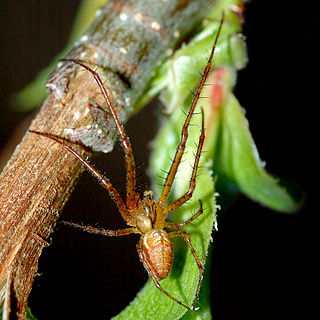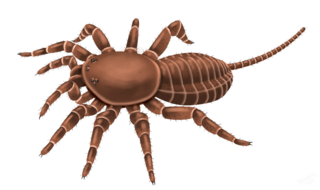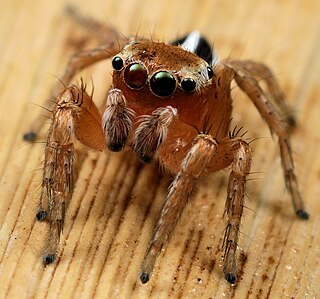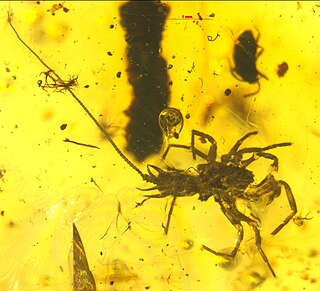
The family Dipluridae, known as curtain-web spiders are a group of spiders in the infraorder Mygalomorphae, that have two pairs of booklungs, and chelicerae (fangs) that move up and down in a stabbing motion. A number of genera, including that of the Sydney funnel-web spider (Atrax), used to be classified in this family but have now been moved to Atracidae.

The Mesothelae are a suborder of spiders that includes a single extant family, Liphistiidae, and a number of extinct families. This suborder is thought to form the sister group to all other living spiders, and to retain ancestral characters, such as a segmented abdomen with spinnerets in the middle and two pairs of book lungs. Members of Liphistiidae are medium to large spiders with eight eyes grouped on a tubercle. They are found only in China, Japan, and southeast Asia. The oldest known Mesothelae spiders are known from the Carboniferous, over 300 million years ago.

The spider family Liphistiidae, recognized by Tamerlan Thorell in 1869, when broadly circumscribed to include two subfamilies, comprises 8 genera and about 100 species of medium-sized spiders from Southeast Asia, China, and Japan. They are among the most basal living spiders, belonging to the suborder Mesothelae. In Japan, the Kimura spider is well known. In 2022, it was proposed to re-accept the subfamily Heptathelinae as the family Heptathelidae. As of December 2023, this proposal was accepted by the World Spider Catalog. In this circumscription, the family Liphistiidae has only one genus, Liphistius.

Oonopidae, also known as goblin spiders, is a family of spiders consisting of over 1,600 described species in about 113 genera worldwide, with total species diversity estimated at 2000 to 2500 species. The type genus of the family is OonopsKeyserling, 1835.

Selenopidae, also called wall crab spiders, wall spiders and flatties, is a family of nocturnal, free-ranging, araneomorph spiders first described by Eugène Simon in 1897. It contains over 281 species in nine genera, of which Selenops is the most well-known. This family is just one of several families whose English name includes the phrase "crab spider". These spiders are often called "Flatties" due to their flattened dorsal profile. The Afrikaans name for these spiders is "Muurspinnekop," which translates directly to "wall spider." The name Selenopidae comes from the greek moon goddess, Selene, as their eyes resemble the moon.

Long-jawed orb weavers or long jawed spiders (Tetragnathidae) are a family of araneomorph spiders first described by Anton Menge in 1866. They have elongated bodies, legs, and chelicerae, and build small orb webs with an open hub with few, wide-set radii and spirals with no signal line or retreat. Some species are often found in long vegetation near water.

Archaeidae, also known as assassin spiders and pelican spiders, is a spider family with about ninety described species in five genera. It contains small spiders, ranging from 2 to 8 millimetres long, that prey exclusively on other spiders. They are unusual in that they have "necks", ranging from long and slender to short and thick. The name "pelican spider" refers to these elongated jaws and necks used to catch their prey. Living species of Archaeidae occur in South Africa, Madagascar and Australia, with the sister family Mecysmaucheniidae occurring in southern South America and New Zealand.

Megarachne is a genus of eurypterid, an extinct group of aquatic arthropods. Fossils of Megarachne have been discovered in deposits of Late Carboniferous age, from the Gzhelian stage, in the Bajo de Véliz Formation of San Luis, Argentina. The fossils of the single and type species M. servinei have been recovered from deposits that had once been a freshwater environment. The generic name, composed of the Ancient Greek μέγας (megas) meaning "great" and Ancient Greek ἀράχνη (arachne) meaning "spider", translates to "great spider", because the fossil was misidentified as a large prehistoric spider.
Paleontology or palaeontology is the study of prehistoric life forms on Earth through the examination of plant and animal fossils. This includes the study of body fossils, tracks (ichnites), burrows, cast-off parts, fossilised feces (coprolites), palynomorphs and chemical residues. Because humans have encountered fossils for millennia, paleontology has a long history both before and after becoming formalized as a science. This article records significant discoveries and events related to paleontology that occurred or were published in the year 2004.
Eoplectreurys is an extinct monotypic genus of spider from the family Plectreuridae, with a sole species, Eoplectreurys gertschi. The fossils of Eoplectreurys were recovered from the ~164 Ma old Middle Jurassic Daohugou formation tuffs in Inner Mongolia, China.
Palaeoperenethis is an extinct monotypic genus of nursery web spider family Pisauridae, and at present, it contains the single species Palaeoperenethis thaleri. The genus is solely known from Early Eocene, Ypresian Okanagan Highlands deposits in the Cariboo region of British Columbia, Canada.

Mongolarachne is an extinct genus of spiders placed in the monogeneric family Mongolarachnidae. The genus contains only one species, Mongolarachne jurassica, described in 2013, which is presently the largest fossilized spider on record. The type species was originally described as Nephila jurassica and placed in the living genus Nephila which contains the golden silk orb-weavers.

Uraraneida is an extinct order of Paleozoic arachnids related to modern spiders. Two genera of fossils have been definitively placed in this order: Attercopus from the Devonian of United States and Permarachne from the Permian of Russia. Like spiders, they are known to have produced silk, but lack the characteristic spinnerets of modern spiders, and retain elongate telsons.
Garcorops is a genus of east African wall spiders that was first described by J. A. Corronca in 2003. As of September 2019 it contains three species, found on Madagascar and Comoros: G. jocquei, G. madagascar, and G. paulyi. In addition, one species, †Garcorops jadisBosselaers, 2004 , is only known from a fossil found in copal on Madagascar:
Burmesarchaea is a diverse extinct genus of spiders, placed in the family Archaeidae. The type species Burmesarchaea grimaldii was first described in 2003 and least 13 more species have been assigned to the genus. The genus has been exclusively found in Cretaceous Burmese amber, which is dated to 99 million years ago.

Evarcha acuta is a species of jumping spider in the genus Evarcha that lives in Namibia, Seychelles and South Africa. The species was first described in 2006 by Wanda Wesołowska. The spider is small, with a carapace measuring typically 1.6 mm (0.06 in) long and an abdomen between 1.4 and 1.9 mm long. The carapace is light brown with a short black eye field. The abdomen has patterns that vary depending on geography. The holotype, found near Brandberg Mountain in Namibia, has lines of brown patches on the top. Examples found in Free State, South Africa, have black lines on the top and sides. The spider can be most easily distinguished from other spiders in the genus by its copulatory organs. The male has a distinctive notch on a long straight projection from its tibia known as a tibial apophysis and a long embolus. The female has not been described.

Evarcha pinguis is a species of jumping spider in the genus Evarcha that lives in Ethiopia. The species was first described in 2008 by Wanda Wesołowska and Beata Tomasiewicz. The spider is larger than others in the genus, with a cephalothorax measuring 3.4 mm (0.13 in) long and an abdomen between 4.7 mm (0.19 in) long. The spider is dark brown and hairy apart from a lighter streak on the back of the carapace and a pattern of light chevrons down the back of the abdomen. The legs are brown, the front four being thicker and shorter than the rest. The copulatory organs are distinctive. The female has marked sclerotization to the edge of its epigyne. The male has not been described.

Seppo is an extinct genus of spiders, possibly of the superfamily Palpimanoidea, that lived about 180 million years ago, in the Early Jurassic of what is now Europe. The sole species Seppo koponeni is known from a single fossil from Grimmen, Germany. With the scorpion Liassoscorpionides, it is one of the two only known arachnids from the Lower Jurassic of Germany. Seppo is the first unequivocal Early Jurassic spider, and was recovered from the Green Series member of the Toarcian Ciechocinek Formation.

Chimerarachne is a genus of extinct arachnids, containing five species. Fossils of Chimerarachne were discovered in Burmese amber from Myanmar which dates to the mid-Cretaceous, about 100 million years ago. It is thought to be closely related to spiders, but outside any living spider clade. The earliest spider fossils are from the Carboniferous, requiring at least a 170 myr ghost lineage with no fossil record. The size of the animal is quite small, being only 2.5 millimetres (0.098 in) in body length, with the tail being about 3 millimetres (0.12 in) in length. These fossils resemble spiders in having two of their key defining features: spinnerets for spinning silk, and a modified male organ on the pedipalp for transferring sperm. At the same time they retain a whip-like tail, rather like that of a whip scorpion and uraraneids. Chimerarachne is not ancestral to spiders, being much younger than the oldest spiders which are known from the Carboniferous, but it appears to be a late survivor of an extinct group which was probably very close to the origins of spiders. It suggests that there used to be spider-like animals with tails which lived alongside true spiders for at least 200 million years.

Lagonomegopidae is an extinct family of spiders known from the Cretaceous period. Members of the family are distinguished by a large pair of eyes, positioned on the anterolateral flanks of the carapace, with the rest of the eyes being small. They have generally been considered members of Palpimanoidea, but this has recently been questioned. Members of the family are known from the late Early Cretaceous (Albian) to near the end of the Late Cretaceous (Campanian) of Eurasia, North America and the Middle East, which was then attached to Africa as part of Gondwana. They are generally assumed to have been free living hunters as opposed to web builders.














